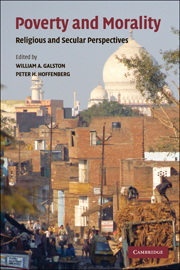Book contents
- Frontmatter
- Contents
- Contributors
- Acknowledgments
- 1 Introduction
- 2 Global Poverty and Unequal Development
- 3 The Karma of Poverty
- 4 Poverty and Morality in Christianity
- 5 Classical Liberalism, Poverty, and Morality
- 6 Confucian Perspectives on Poverty and Morality
- 7 Poverty and Morality
- 8 Hinduism and Poverty
- 9 The Problem of Poverty in Islamic Ethics
- 10 Jewish Perspectives on Poverty
- 11 Liberal Egalitarianism and Poverty
- 12 Marxism and Poverty
- 13 Poverty and Natural Law
- 14 Afterword
- Select Bibliography
- Index
8 - Hinduism and Poverty
Published online by Cambridge University Press: 05 June 2012
- Frontmatter
- Contents
- Contributors
- Acknowledgments
- 1 Introduction
- 2 Global Poverty and Unequal Development
- 3 The Karma of Poverty
- 4 Poverty and Morality in Christianity
- 5 Classical Liberalism, Poverty, and Morality
- 6 Confucian Perspectives on Poverty and Morality
- 7 Poverty and Morality
- 8 Hinduism and Poverty
- 9 The Problem of Poverty in Islamic Ethics
- 10 Jewish Perspectives on Poverty
- 11 Liberal Egalitarianism and Poverty
- 12 Marxism and Poverty
- 13 Poverty and Natural Law
- 14 Afterword
- Select Bibliography
- Index
Summary
The religion and poverty of India are her two primary materials, of which the whole structure of her society has been – and is still being – built. In relation to them, other considerations seem flippant.
Ronald Segal, The Anguish of IndiaHinduism is the name given to the most widely prevalent religious tradition of India, whose followers constituted about 80 percent of India’s population in 2001. Hinduism has been a prominent feature of the Indian landscape over the centuries, although its origins are shrouded in antiquity. Some trace it as far back as 3000 bce on the basis of archaeological finds in the region of Harappa in the Punjab that already display features we now associate with Hinduism; others date it from around 1200 bce, the date usually assigned to its earliest available literary text, the ṚgVeda. Still others date it from around the fourth century bce, applying the term Vedism rather than Hinduism to the prior period. According to this view, Hinduism represents a transformation of Vedism under the impact of the new religions of Buddhism and Jainism, whose emergence is usually placed in the sixth century bce.
Hinduism, as a continuous religious tradition of such antiquity, invites the appellation of eternity in its own eyes; this would be one way of explaining its own term for itself: sanātana dharma, often translated as eternal religion. But whether eternal or not, it has certainly been a continuous tradition. This point is important for our present discussion because the country we now call India has, in the course of its long history, undergone many vicissitudes of economic fortune, and Hinduism has been a party to all of them, on account of its own long history. This historical fact, as we shall see, complicates the discussion of poverty in Hinduism because one could as well choose to discuss the topic of Hinduism and prosperity, since in its long run Hinduism has been associated with both. The issue is further complicated by the fact that India was a British colony for about two hundred years from circa 1757 to 1947. It is a widely cited statement that “India enjoyed 17.6 percent of the world’s industrial production in 1830, while Britain’s share was 9.5 percent. By 1900 India’s share had declined to 1.7 percent while Britain’s had grown to 18.6 percent.” How is this reversal to be accounted for? Indian scholars tend to blame it on imperialism, and British scholars on Hinduism.
- Type
- Chapter
- Information
- Poverty and MoralityReligious and Secular Perspectives, pp. 160 - 179Publisher: Cambridge University PressPrint publication year: 2010
- 2
- Cited by

